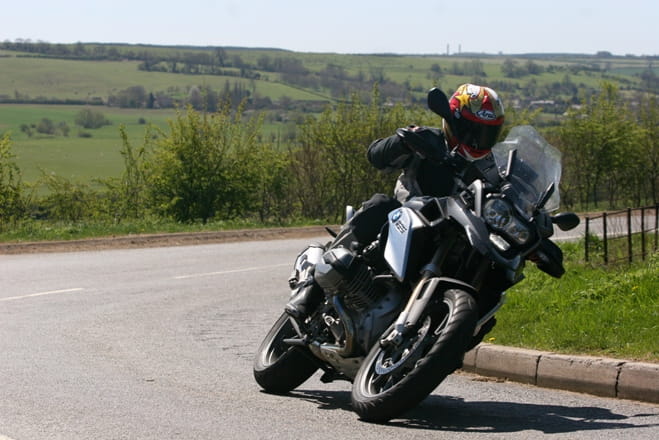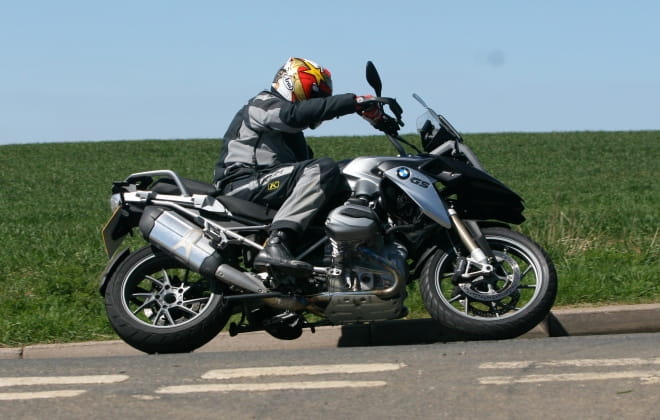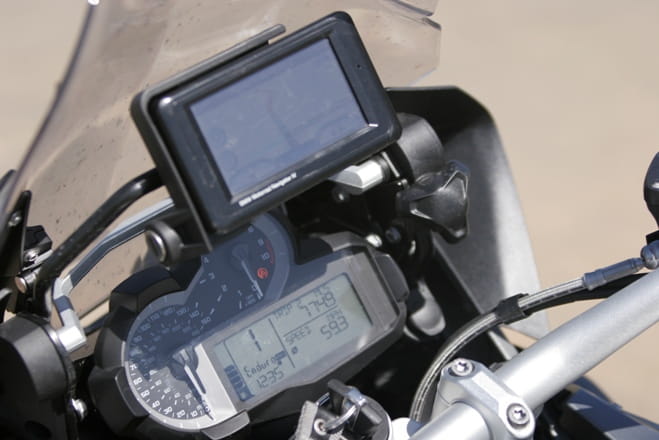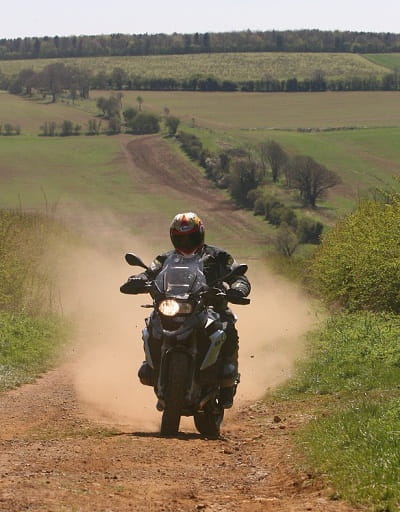Living With: 1000 miles on BMW's 2013 R1200GS

The new BMW R1200GS might look quite a lot like the old one to the untrained eye. We'll forgive you for thinking that.
Despite owning four GS’ in the past, I still had to park next to an older model to spot all the differences, yet it was tesitimony to the GS' appeal just how many people actually noticed the new liquid-cooled GS over the last few days.
From Peterborough to London, Guildford to Stafford, the Welsh borders to Cambridge, never before have I been asked so many times what a bike is like as I have over the last two weeks I’ve been riding the new liquid-cooled BMW R1200GS.
That’s amazing on two counts because it’s all-new, yet unless you are a real GS anorak then you’d struggle to notice the differences unless they were pointed out to you. Or so I thought. The British motorcycling public seem to have other ideas. A tip? Look for the LED headlight, and if that's not fitted as an option, then the carb stacks on the new bike are vertical.
That means they’re more out of dirt and water when off-road as they sit higher, yet annoyingly means you can’t rest your legs on the pots and use them as highway pegs/leg warmers like you could on the older bike. Just ask a GS owner, they’ll tell you.
The GS has consistently been the best-selling big capacity motorcycle in the UK for four years yet still has a bit of stigma attached to it. It's not all beards with BMW's anymore, they are building some class leading bikes, make no mistake.
Like it or not, we are a nation of GS lovers and with 180,000 R1200GS’ sold over the last nine years, worldwide. That’s excluding the similar, but bigger Adventure.
Love them or hate them, the GS is here to stay.
The good news is that despite a new engine, which BMW are describing as air and oil cooled, a new chassis, semi-active suspension, new styling which takes the beak look to a whole new aggressive air, electronically adjustable semi-active suspension, and in fact, new everything, it still feels like a GS.

It’s just faster, sharper, lighter, looks more crafted and stops better than any GS before it. It is the best BMW GS yet made and incredible what it’s capable of. It covers ground quickly, it’s comfortable, fast enough to get you in trouble, yet more than capable enough to extend the limits of what you thought a GS would be capable of.
As previously mentioned, for the first time ever the GS gets liquid-cooling on an all-new 1170cc boxer twin engine. BMW are keen to point out it’s air and liquid-cooled and it uses precision cooling – a feature taken from F1. That directs the cooling liquid to the most thermally stressed areas, yet retains air-cooling to keep the character of the motor. Whatever it does, it works, and the fan system is so advanced it channels hot air away from the rider so you don’t overheat when riding through town. Like the rest of the bike, it’s incredibly clever.
Strangely, as a man who’s run four GS’s over the past ten years, it took me more than the usual thirty or fourty miles to get used to it. The handling felt a little alien, it felt too quick steering compared to the old bike at first. But after fourty miles that all went and I really started to get to grips with it, and what a bike it is.
The motor feels like a GS motor but it’s got more everywhere. There’s more top-end power, making 125bhp at 7700rpm, but it hasn’t sacrificed much of the old air-cooled bike’s torque.
Hit 70mph in top gear and it’s right on song at 4000rpm with enough to overtake without changing down, something you had to do on the old bike to make proper progress. The motor has a bit of a step-change at 7000rpm that may even be described as a powerband, but it will keep going to more than 140mph on the speedo too, something that would have never happened on the old one.
At lower speeds there’s still that warble from the boxer twin lump, and a slight bit of sideways wobble when you blip the throttle from the torque reaction, but most of it has been dialled out. There are different settings for the suspension, traction control and ABS. They range from Road, Wet, Dyna (for Dynamic), Enduro, and Enduro Pro. I spent the first few days riding round in Dyna and Hard suspension modes, but after a few days went back to Road and Normal suspension settings, finding the suspension more plush yet easily able to cope with fast riding, and the throttle not overly sensitive.
In town the GS has never been easier to ride. The old dry clutch, which ate itself faster than a starved Labrador with its face in a bag of doughnuts, has been swapped for an anti-hop wet clutch. It’s smooth, combined with a gearbox that’s still not Suzuki slick, it’s a massive step on, but it’s way better than the previous generation.
What really freaks you out, if you’re used to riding a GS, is that the fan cuts in when in town for a while, something that’s completely alien to GS riders, as they’ve always been air-cooled. This bike actively directs air away from the rider when the fan blows so you never get hot and bothered. Despite the liquid-cooling, all the fans and electrics and the tucked-away radiators that come with it, the system only adds 2.7kg to the bike’s overall 238kg wet weight.
The motor will short shift, or you can rev it out and it never complains, singing all the way to 9000rpm if that’s your bag. But for most of the time, the GS has plenty of power everywhere, something that was lacking from the old bike and had some GS owners seeking higher performance from bikes like the brilliant Ducati Multistrada and new KTM Adventure. Both of those bikes offer 150bhp-plus, but the GS uses it so well you never feel it’s lacking compared to its faster, slightly more sporty European rivals.
Helping you keep it all in line is an all-new chassis, if you can call it a chassis as it all basically hangs off the engine. But, the motor sits higher than before, and the cylinders are also higher on the block so you never worry about scraping cylinders like you could on the old one if you got a pace on.

There have been lots of rumours, gossip and speculation that the GS suffers from some kind of instability problem. It’s quick-steering, yes, and gets you into a turn faster than any GS before it, but although it feels like there’s never that much weight on the front tyre, in 1000 miles I never had any instability issues. I tried to get it into a wobble at high speed by banging on the bars and it never gave more than a gentle wobble before recovering quickly. For those of you who remember the nineties, this is no TL1000S. It’s just an incredibly quick-steering adventure bike, and the handling is all the better for it.
You can tour gently and it sings through bends, using low revs to make the most of the flat-twin burble, or you can hustle.
In full hustle mode I occasionally turned the settings to Dyna for increased throttle response, and hard suspension for a bit firmer feel. But in truth it never really needed it, although you can feel the settings making a difference.
In Road mode, the traction control works perfectly, saving me from more than one slide. It’s intrusive under very hard power in the first two gears, flashing its orange lights at you and numbing the power, but it’s basically stopping you from wheelying, and that can only be a good thing. It gets less restrictive, and I guess, less safe as you flick through Dyna mode.
In the wet I used Rain mode, but to be honest, if you’re a decent rider you don’t really need it. It makes all the safety devices cut in much earlier and can be dialled in with the push of a button, just whip the clutch in and it activates. The tyres may look like they don't shift much water, but they feel great on this bike in the rain.
The brakes are Brembo Monoblocs and never leave you asking for more power. In the wet you can get the ABS to cut in but only if you're trying to really hard. We didn’t datalog the bike, but I’d bet a fiver that it stops better than any GS before it, perhaps even better than the sportier Multistrada and that’s got some serious anchors on it.
I did a number of full to empty tank runs and never really thought that much about comfort. There’s a variety of seats available at the time of ordering, and the seat can be adjusted for angle and height. I just left it on a slightly lower setting so I could clear the windblast from the screen by sitting a few millimetres lower.
On the motorway the bike is an incredibly pleasant place to be, especially on the Touring Edition, which comes with cruise control and is ready wired in for you to buy a BMW sat nav which you can operate through the bike’s electronics on a thumb wheel.

Cleverly, the screen has been fitted with two side deflectors so the wind protection is better than ever, but it could have done with a couple more millimetres on top to clear my six foot four frame. It was close though. You can adjust it using a knob on the right hand-side of the bike’s clocks, which you use your left hand on. It seems weird at first, but ride and it makes sense. BMW didn’t want us to take our hands off the gas, so designed it this way on purpose.
The cockpit screen and dash is all mounted on a Magnesium mounting for lightness, and the clocks and gadgets are some of the best around. There’s mpg, trip meters, fuel gauge, a countdown to tell you when you’re going to run out of fuel, a display for the heated grips fitted to our TE (Touring Edition version). It was registering 43mpg during my test, and at that was ready to fill up at about 130 miles per tank when the fuel light showed. You’ve got another 30 miles or so on top of that. Admittedly, I was possibly riding it slightly harder than some would, so you can achieve better I’m sure.
 OFF-ROAD:
OFF-ROAD:
For a laugh we took the GS off-road for a few miles of some gentle trails and managed to get it stuck in some ruts after a few. Most of this was due to the road-biased tyres called Metzeler Tourance Next. They’re ace on the road, but off-road only upto very hard gravelly tracks. A bit of muscle soon got it out of the ruts but
Whack the settings in Enduro and it dials in high suspension and adjusts the traction control and ABS settings to allow for some slip and sliding under braking and power. But the electronics will still stop you from hurting yourself too much.
You can manually turn both the ABS and traction control off to allows it to lock the wheel up fully, and slide if you want. Alternatively, put it into Enduro Pro mode and it turns all the safety controls off, adjusts the suspension and lets you ride like a fool. It’s designed to be used with knobbly tyres for serious off-road riding.
Off-road, the old bike used to be a faff off-road as you had to turn the ABS and TC button down everytime you turned the bike on or off, but on the new one it stays as you set it until you tell it otherwise. The test riders and engineers did that on purpose because when they were testing it back-to-back with the KTM they noticed that the KTM’s ABS could stay switched off and the rider was gone, while they were pushing buttons. BMW don’t like to lose, even when testing in a quarry.

The bike feels way more manageable on gentle off-road trails than the old one, the suspension is leagues ahead and it can cope with more than I can throw at it. Get it sideways on the lock stops and you can juggle the fly-by-wire throttle on the gas to keep it spinning. A word of warning though, you need to be pretty brave and committed with it as at 238kg fully-fuelled, this is no lightweight dirt bike.
Our bike had cast wheels fitted, but spoke wheels are available as a £355 optional extra. This would allow more variety of semi-off-road tyre fittings on the rims.
VERDICT:
+ Points – The GS just got considerably better. The best all-round adventure bike? It looks like the old one so good for resale
- Points – It looks like the old one
TECH SPEC - BMW R1200GS (Touring Edition tested)
|
Engine
|
1,170cc, Air/liquid-cooled, four stroke, flat twin engine, DOHC
|
|
Drive
|
Shaft, 6-speed gearbox
|
|
Chassis
|
Two section frame, front and bolted-on rear frame, load-bearing engine
|
|
Power
|
92 KW / 125 bhp @ 7,750 rpm
|
|
Torque
|
125 Nm @ 6,500 rpm
|
|
Brakes
|
Front: Dual disc brake, floating brake discs, diameter 305 mm, 4-piston radial calipers
Rear: Single disc brake, diameter 276 mm, double-piston floating caliper
ABS: can be switched off
|
|
Tyres
|
Front: 120/70 R19
Rear: 170/60 R 17
|
|
Dimensions
|
Length: 2,210mm
Width: 953mm
Height: 1,450mm
Seat height: 850 - 870mm
|
|
Weight
|
238kg
|
|
Fuel tank capacity
|
20 litres (plus 4 litre reserve)
|
|
Colours
|
Grey, Red, Blue, White
|
|
Price (as tested)
|
£13,815
|






 OFF-ROAD:
OFF-ROAD: